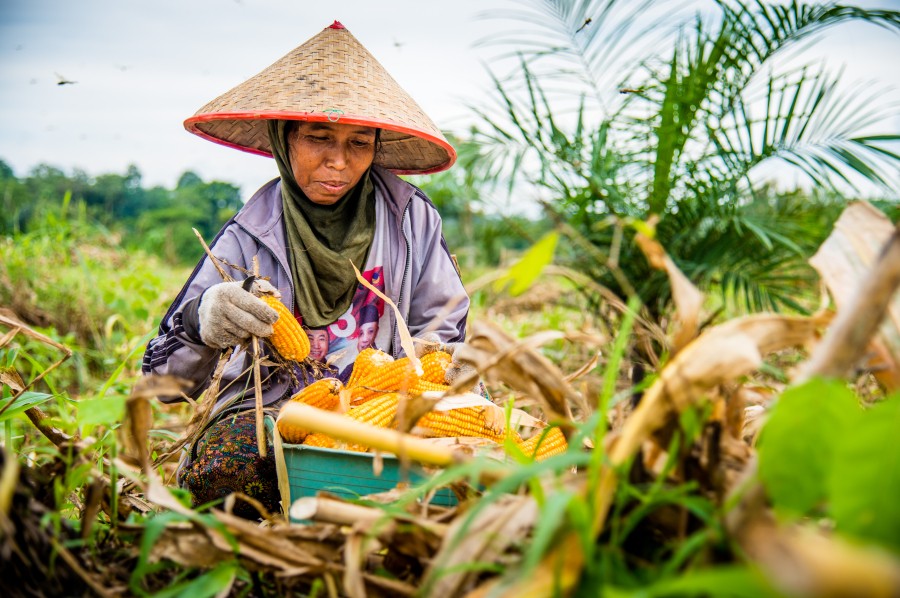Oikocredit Canada announced the wind down of its operations in Canada (November 29 | 2023). This marks the end of over 40 years of successful operations in Canada, effective Dec 31,2023. Click to read more.
Read more
Investment in small farmers key to feeding the world and reducing poverty
Investment in small farmers key to feeding the world and reducing poverty
According to UN estimates, the world population is expected to grow from about seven billion currently to more than nine billion by 2050. This means that farmers around the world are going to have to produce a lot more food, while limiting their impact on land, water and the global climate.
Smallholder farmers – once disdained by experts as unimportant and inefficient – are now being heralded as the key to unlock this dilemma. Using local knowledge and working local land, smallholder farmers are helping to fight back against the corporatization of land and resources. In turn, this creates a more sustainable approach to agriculture, keeping environmental impacts and carbon emissions in check.
But can these farmers ramp up production to meet the huge food needs of the future?
The answer is yes, but there is a big “if” attached to this. That is, if they can get the financing necessary to improve productivity.
A report last year from the Initiative for Smallholder Finance and the MasterCard Foundation sketched out the challenges in this massive undertaking.
 The social enterprise Vasham Kosa Sejahtera (VKS), founded in 2013, provides value-chain financing to smallholder maize farmers with average plot sizes of less than one hectare. The model helps reduce production risks and ensures optimal harvests. By linking farmers with input suppliers, feed mills and buyers, VKS provides them with access to a value chain, which would otherwise remain inaccessible given their size and production volumes. Thanks to this linkage farmers pay less for their inputs and receive a higher price for their produce. VKS is Oikocredit's first agricultural partner in Indonesia and has been an Oikocredit partner since 2017. In the photo: A female worker harvesting corn.
The social enterprise Vasham Kosa Sejahtera (VKS), founded in 2013, provides value-chain financing to smallholder maize farmers with average plot sizes of less than one hectare. The model helps reduce production risks and ensures optimal harvests. By linking farmers with input suppliers, feed mills and buyers, VKS provides them with access to a value chain, which would otherwise remain inaccessible given their size and production volumes. Thanks to this linkage farmers pay less for their inputs and receive a higher price for their produce. VKS is Oikocredit's first agricultural partner in Indonesia and has been an Oikocredit partner since 2017. In the photo: A female worker harvesting corn.
A new era
“A renewed drive at the beginning of the 21st century to connect farmers to financial services has ushered in a new ‘era of farmer finance,’” states the report. “Even with these developments, however, the gap between the financial needs of smallholders and the supply of financial services is anticipated to remain significant.”
The report estimates that the 270 million smallholder farmers in Latin America, sub-Saharan Africa, and South and Southeast Asia, need more than $200 billion annually in investment capital. State banks in developing countries, microfinance institutions, commercial banks, agribusiness lenders, non-profit organizations and social lenders like Oikocredit, the organization I work for, are doing their part. But even with significant effort on the part of these actors, only about $50 billion is disbursed each year – leaving $150 billion gap in financing.
The report, titled Inflection Point: Unlocking growth in the era of farmer finance, calls for a plan of action from all players – farmer organizations, financial institutions and national governments to make the changes necessary to unlock the growth potential.
The report focuses on three strategies. First, the farmer must be put at the centre of product development, with loans and technical assistance bundled to make financing more accessible and attractive. Second, financial institutions, agribusiness and non-governmental organizations need to develop progressive partnerships to serve smallholders, reducing costs and opening up new markets. And third, philanthropic and public contributions should be targeted together to create “blended finance” strategies with “smart subsidies” to reduce risk and increase the supply of capital.
A call to action
“Now is the time to put smallholder finance on a new trajectory that will help millions of smallholder farmers secure a more prosperous future for themselves and their families,” states the report.
It’s time for socially responsible investors and the institutions they support to get behind this great opportunity of small-scale agriculture. The income of local communities, the food security of millions of people and the well-being of the Earth’s environment and climate depend on it.
This blog was originally published in Your Guide to Responsible Investing.

